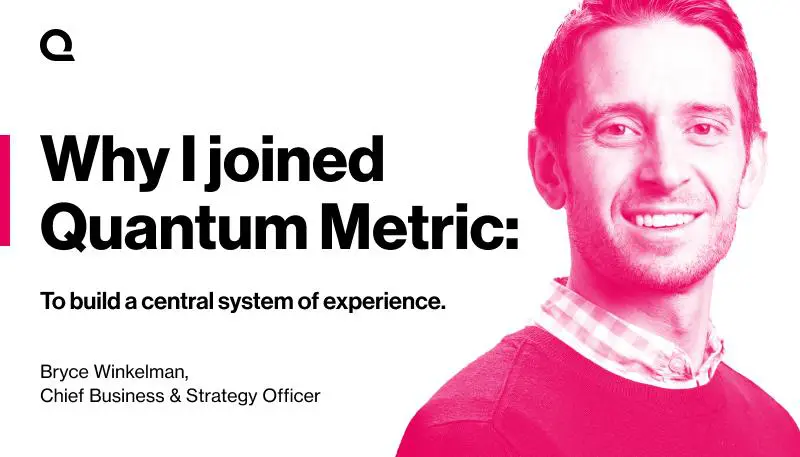Why I joined Quantum Metric: To build a central system of experience.

About six years ago, I was sitting with a Fortune 500 retailer in a conference room at my company’s headquarters. We had just gotten the customer’s digital VoC program off the ground and the sentiment data was rolling in. Right as we were about to take a victory lap, they lowered the boom.
They loved the data they were getting, but wanted to know how to prioritize what issues to address first. The questions kept coming. What was systemic vs. one loud voice? How could they get more granular detail into what the customer was actually experiencing? And where should they be placing additional “intercepts” to engage with their customers to get direct customer feedback?
What the digital team wanted was the ability to actually see customer sentiment in context of what the customer was experiencing and how they were behaving. It wasn’t just about prioritization. The retailers wanted to develop deeper empathy for their customers. The data we provided them with was incredibly valuable, but I realized there was another side of the equation – the behavioral side. We often talked about “X” and “O” data, and this was a case study in why this data needed to live side-by-side.
Understanding customer behavior would not only bring the retailer’s VoC data to life. It would enable them to drastically reduce how long it took to act on the insights they were receiving and make a major impact on their business.
Colliding worlds.
Over the years I sat in many conference rooms with enterprise customers ranging from airlines, to financial services, to retail, to hospitality, watching this same scenario play out. They all loved their VoC programs, but the lingering question remained: How can we shine a light on the silent majority, contextualize their sentiment, recreate the issue, see how big of a problem it is—and do all of this in a fraction of the time that it usually took?
But for this to happen, three separate worlds would need to come together.
- The sentiment side of what people are saying
- The quantitative side of where people are clicking (or abandoning), and
- The experience side of what people are seeing
If these three worlds collided, there would be a far more powerful story to tell around why people were behaving the way they did, and how to prioritize it.
We need empathy now more than ever.
We’ve all heard it: the pandemic accelerated digitization of the customer journey across the board.
Whether fully prepared or not, brands are now having to pour money and energy into digital experience management. As the customer journey transitions to digital, this is now the new battleground on which customer loyalty will be built or destroyed.
In the past, organizations had more control over their brand experiences, especially when they all took place in-person. They could train their employees to be ‘Mom & Pop shop nice.’ Meaning not only polite, but actually expressing warmth to their customers as they navigated their aisles, spoke with their tellers, or asked an agent for help. Employees could immediately have empathy for their customers’ needs.
Now the question is, how do we translate that empathy into the digital world?
Empathy for the digital customer comes through understanding their goals and behavior, and building experiences based on that. However, there is an additional twist when it comes to digital.
An excellent empathetic digital experience is also based on speed and simplicity. In fact, often, accomplishing a task quickly and seamlessly is the single most important variable for digital customers. In the past, brands could deliver a great customer experience through a winning smile, quality selection, and value. Today, the challenge for brands is delivering a customer experience that is just as meaningful across its digital challenges, while at the same time prioritizing speed and simplicity.
To truly empathize with the digital customer, we need the full perspective, including sentiment, behavior, and operational business data – all wrapped in visual evidence. And we need all digital stakeholders aligned around it.
Building a central system of experience.
But alignment has been a challenge. With so many point solutions, enterprise teams were—and still are—both drowning in data and lacking in insights.
Over the years, I have seen too many organizations trying to operate a digital VoC program separate from their analytics program, and separate from product – which has led to more confusion across the org.
Battles were raging across departments, with product teams going to IT and saying “we have a performance problem,” and IT responding “our system isn’t telling us that.” As digital became a critical driver of loyalty and brand perceptions, teams could not afford to work in silos like these any longer. These teams need to work together as one team with a common goal of improving the end to end digital experience for their customers. Often effective collaboration requires common platforms and data. This common approach to data turns data into an enabler of speed and collaboration instead of a battleground.
Five years ago, I realized this organization-wide disconnect had reached a boiling point for many companies. That is when I met Mario Ciabarra, who was founder of a then budding startup called Quantum Metric. I’ll never forget how, in yet another aforementioned conference room, he broke out a demo of Quantum Metric and blew my mind.
The first thing that I thought (and the first thing I said to Mario) was, “Wow, wouldn’t it be cool to see all of this data in context of an NPS score?” To which he assuredly responded, “No problem, we’ll have it done in a few weeks”.
Frankly, I didn’t believe him. But true to his word, he came back a few weeks later with it built into the product. Again, my jaw hit the floor. It was clear the technology was something special.
Mario and his team at Quantum Metric had built what nobody else thought was possible – a central system of experience for all digital stakeholders. A system that everyone can use and truly understand what people are doing and harness all these different stakeholders to come together and focus on the customer. It’s a system that is geared to operate across an organization’s disparate teams and areas of focus.
Joining Quantum Metric.
Of course, the promise of data democratization and single version of truth is easier said than done. The challenge is solving all of these problems, across disparate teams, in one place – and at scale.
Speed is the name of the game, and the organizations that are fastest to iterate and adapt one step ahead of the customer will win every time. That requires complete collaboration across one system. Silos must become a thing of the past.
I joined Quantum Metric because it’s the place that’s come closest to solving this problem. I have been in the front row before, watching the creation of a category, and saw firsthand how one platform can transform an organization. Quantum Metric is building a platform that has the breadth and depth to span multiple users in multiple functional areas, all with the same goal – Continuous Product Design. This is the present and the future of Quantum Metric, and frankly, it is invigorating. Their innovative approach is transforming organizational culture around teamwork, collaboration, and an intensive focus on the customer.
As more and more customers achieve success with our platform and Continuous Product Design methodology, I couldn’t be more excited to be aboard this rocket ship and working with an amazing team, both of which will shape the next exciting chapter of my career.








